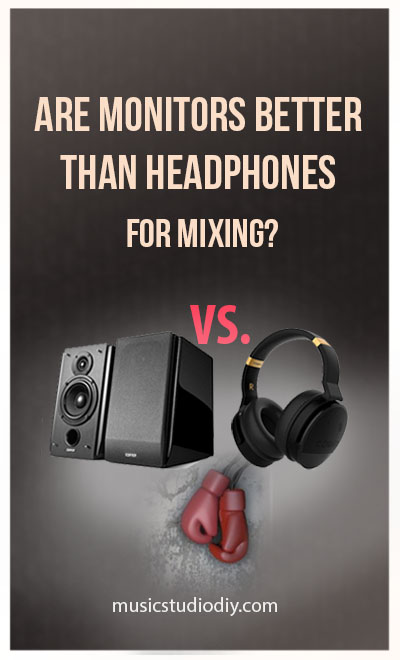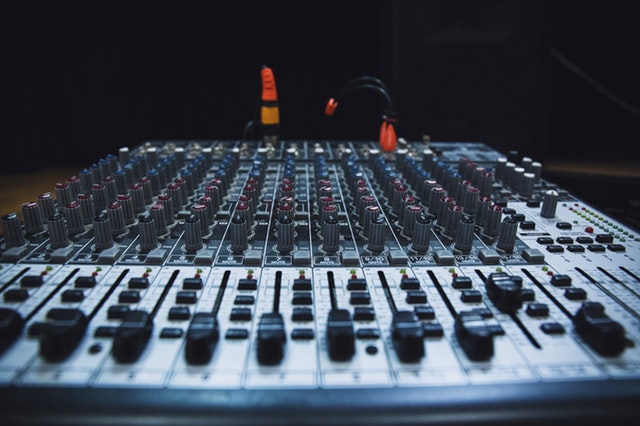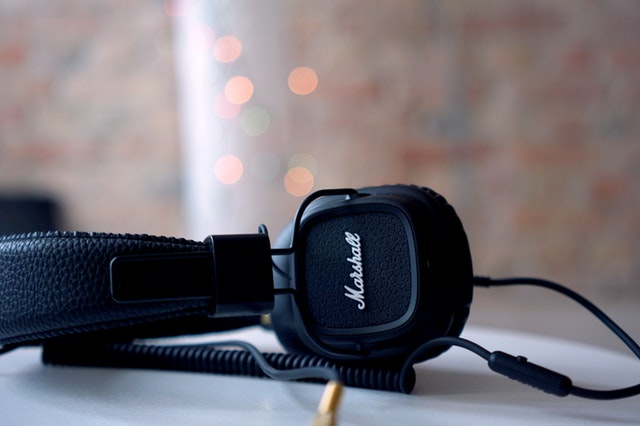 It is pretty simple to see why this is a hotly debated topic, particularly amongst home music producers… Are monitors better than headphones for mixing?
It is pretty simple to see why this is a hotly debated topic, particularly amongst home music producers… Are monitors better than headphones for mixing?
Generally, the commonly pushed idea amongst professionals is that a good set of studio monitors is the ideal way to go. However, decent monitors are known to be on the more costly end of things. And because of this, the appeal of using headphones becomes grossly apparent. Not only that, but the thought of evading the investment of an elaborate control room with intricate acoustic treatment is pretty alluring for beginners on a budget…
So, can you really get away with mixing solely on headphones? Are monitors better than headphones for mixing? And even so, do we really need to pick one over the other? To have all these contentious questions answered, read on.
In this article we look at:
- Why is Monitoring Important for Studio Mixes?
- Why are Monitors Generally Considered Better?
- Technical Differences: Headphones vs. Monitors
- Can you Mix an entire song on Headphones?/The Verdict
Why is Monitoring Important for Studio Mixes?
Monitoring forms an integral part of your overall studio time. This is a really important component in many aspects of audio, including the recording, mixing and mastering processes. Essentially, monitoring serves several critical purposes in the studio such as:
1. Technical Refinements
 Firstly, all technical sonic components need to be analyzed accurately by the producer or sound engineer. The fine details of your track would be rectified and perfected during your mixing/monitoring processes. This would include aspects such as, amongst others, correcting pitch adjustments, and removing excess resonances/reflections. Also eliminating irregularities in the song like clicks or hisses would be performed here.
Firstly, all technical sonic components need to be analyzed accurately by the producer or sound engineer. The fine details of your track would be rectified and perfected during your mixing/monitoring processes. This would include aspects such as, amongst others, correcting pitch adjustments, and removing excess resonances/reflections. Also eliminating irregularities in the song like clicks or hisses would be performed here.
Mixing is a detailed and multi-faceted procedure that every producer undertakes in the studio. Producers want to monitor with careful detail, and with equipment that will flatly produce the truthful nitty-gritty bits of the track. Mixing requires an immaculate attention to detail that can only be further enhanced by your choice of monitoring equipment.
2. Portability and Sonic Experience
Monitoring, in this regard, will also determine the overall portability of the song. Meaning that the listener should have more or less the same sonic experience, whether it is using headphones or listening via their car radio for example. A song should sound awesome irrespective of where or how you listen to it. The truth is that, sometimes, these discrepancies can occur depending on what you choose to monitor with i.e. headphones v.s monitors (We’ll delve into this aspect a little later).
Producers/Engineers need to determine, with more precision, what the listener will ultimately hear when listening to the song. Which is why it becomes all the more critical to ask, are monitors better than headphones for mixing?
Why are Monitors Generally Considered Better for Mixing?
What makes monitors better than headphones for mixing? You probably know by now that the popular opinion amongst professionals is that Studio Monitors are the better way to go. They’d even argue that using both in conjunction is actually ideal… which isn’t all that far-fetched, to be honest. But since we’re talking choosing one over the other for the sake of budget and effectiveness, we’re naturally going to compare.
Monitors are typically thought to be the superior of the two. This is because monitor mixes generally translate better from speakers to headphones as opposed to the other way around. Mixing the other way around (from headphones to monitors) would often require a lot more tweaking and adjustment, basically doubling your workload. We discuss these issues below.
Technical Differences: Headphones vs Studio Monitors for Mixing
Substituting monitor speakers for a set of headphones may strike some as a simple exchange. A preferable on even. And while it does offer a number of advantages, it does come along with a few complexities. Let’s take a look the key differences between the two, shall we?
Perception of Sound
There are many significant differences between experiencing sound through monitor speakers in comparison to headphones. Much of these variations have to do with the way in which sound is perceived by the human auditory system. In the real world, we have a sense of directional sound based on timing and frequency variations. This refers to whether sounds reach the left or right ear first.
Monitors
When listening through a set of monitor speakers, sound reflections in a room become a factor. Additional resonances, other than the direct sound, create more of an ambiance. This can affect the listener’s perception of the sound in an environment not treated for room acoustics.
However, monitoring over speakers, in this regard, gives you a better sense of what a song may sound like in a spacious, real-world environment. This is more complex to get right. Songs are commonly meant to be heard in public settings, or simply over the radio or on anything other than headphones in particular. Generally, if you can get a song to sound good in a room with monitors, it is bound to sound great using headphones as well.
Headphones
Headphones, on the other hand, eliminate the factor of room acoustics altogether. Listeners hear sounds at the same time through each earpiece. Because of this, you would only hear a manufactured directional sound. This would include elements such as reverbs, panned instruments as well as delays.
The disadvantage here is that you could end up putting together a mix with a more sterile, clinical sound in a real-worl setting. Listeners hear music with less liveliness this way, so you’re likely to end up having to go back and adjust your mix by adding reverbs etc. However, headphones are still hugely advantageous in that, you’re able to hear finer details missed using monitors. They’re especially useful when it comes to spotting factors like subtle clipping and clicks, pitch/timing distortions etc.
Pros & Cons Converting Headphone Mixes to Monitors
Sure, many people will argue that they’ve successfully managed to mix songs using headphones alone. And it can be totally doable if you really know what to look out for. Mixing primarily using headphones often leads to a lot of misjudgment in your track. Headphone mixes can easily sound totally different when listening to them through monitors after.
The Cons of Mixing with Headphones
-
- As previously mentioned, your mixes are prone to being more sterile and dry. Particularly when it comes to vocals and synths. Headphone mixes tend to lack a certain liveliness provided by adding enough reverb or delays etc. when listened to through speakers.
-
- Musicians also end up creating mixes with a stereo field that is too narrow. Essentially, you want the right amount of depth and width between instruments in the mix.
-
- Effects such as delays, panning, and reverb typically become more prominent through headphone mixing. This becomes highly noticeable when listening through monitors afterward. Widening your panning will become necessary here for an easier conversion to speakers.
-
- Volume levels in general also tend to be an issue. Your subtle elements, as well as louder elements, can often easily be miscalculated when mixing with headphones. For example, softer vocal harmonies which can be heard clearly over headphones can end up being too soft speakers. Conversely, percussive elements which may sound moderate in volume over headphones, become too loud over speakers.
The Pros of Mixing with Headphones
Despite the fact that mixing with headphones can present a few issues, there are a number of great advantages that come with using them. So don’t rule them out entirely when considering are monitors better than headphones for mixing:
-
- WORKING IN SILENCE – A seemingly simple place to start. But a major perk of headphones is that, well, you don’t have to worry about disturbing your roommates or neighbors. This is especially if soundproofing your home music studio is not something you’ve factored into your budget.
-
- EASY ON THE BUDGET – An aspect touched on previously. You basically evade the need for not only soundproofing, but also acoustic treatment. Particularly if your studio is more of a control room than a live room. Treating your studio can be a costly task… but totally still worth it. It’s not that headphones are just cheaper (the end ones aren’t), but there’s more that comes with owning studio monitors in price.
-
- ENHANCED ATTENTION TO DETAIL – A more technical aspect here. The flatness of a good quality set of studio monitors would reveal all the intricate details of your track. However, because headphones are literally right against your ears, your perception of these details would only be further enhanced.
-
- MOBILITY – If you’re someone who does a lot of your mixing while traveling from place to place, headphones give you that advantage. You could lug around your monitors wherever you’re headed or, if it suits you better, take advantage of the compact nature of headphones.
So, Can You Mix an Entire Song on Headphones?
In essence, as we’ve observed above, there are several factors that need to be considered when mixing with headphones. It really isn’t just a simple “walk in the park”. These are these are main areas that would generally make monitors better than headphones for mixing?
Ideally, in terms of all the technical components, we’ve looked you could mix solely on headphones, even though it’s not ideal. The best scenario in any studio is actually to use both monitor speakers and headphones in conjunction. This so that you can get a real-world perception of the song when mixing, and then further refine it by using headphones for greater detail.
But if you take into account all the issues we’ve highlighted as far as headphone mixing, you could just get away with it:
Selecting a Good Pair
Depending on what your studio situation is, you need to consider what the best type of headphones are for you as a home music producer. Many of the issues you could experience could be aided by a quality set of headphones. Most of the time, in big pro setups, a high-quality set of open-back headphones would the best.
Closed-Back Headphones
However, in most home music studios, the control room and live rooms are merged. In settings in which recording and mixing could occur simultaneously, you want to go for a closed back set of headphones. You could check out this review of the Beyerdynamic DT770 250ohm headphones, for a good reference.
Alternatively, on a much smaller budget, the Sony MDR7506 Professional headphones could be a nice starting point for beginner mixing. But overall, try to keep to closed-back headphones in this setup.
The Verdict: Are Monitors Better than Headphones for Mixing?
And now for that final judgment… Are monitors better than headphones for mixing?
I think we’ve unpacked in detail within this article the core differences between using studio monitors and headphones. Including the factors that are said to make monitors better than headphones for mixing. In all honesty, the two have their own unique advantageous elements that can only be complimentary toward each other. Headphones are good for certain things, while monitors are good for others, if not most of the elements of mixing. Basically, if it’s within your means, you’d benefit from both.
Essentially, monitors are indeed superior in terms of all the capabilities they offer. However, that doesn’t mean that you can’t use headphones alone at an entry-level. A good set of studio monitors would be far more costly on several levels, in comparison to a high-quality set of headphones for mixing.
So by all means, work with what you can and mix cautiously with your headphones. But definitely work towards adding a good set of monitors to your gear.
If you’d like, take a look at our recommended gear here.


